Hong Kong protests: The symbols and songs explained
- Published
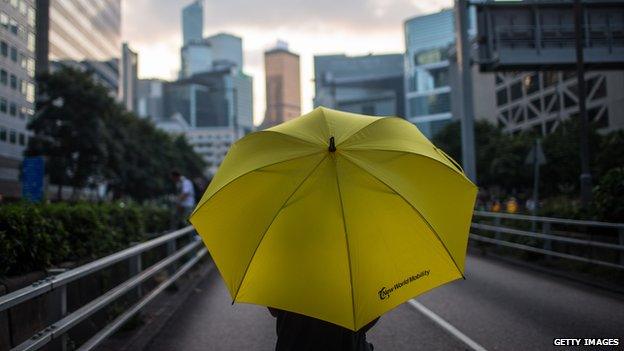
Umbrellas have been used to protect against sunshine, rain and tear gas
After a week of pro-democracy protests in Hong Kong, many symbols and songs have emerged as favourites among demonstrators.
Here is a look at some of the most common sights and sounds on the streets - and what they mean.
Yellow ribbons
Yellow ribbons have become synonymous with Hong Kong's pro-democracy movement, with protesters taking up Tony Orlando and Dawn's song Tie a Yellow Ribbon Round the Ole Oak Tree.
The ribbons adorn railings and trees around the territory's government buildings.
Meanwhile supporters around the world have joined Hong Kongers in pinning the ribbons to their shirts and posting them on their social media profiles.
Yellow has long been the official colour of many suffrage organisations, stemming from the women's suffrage campaign in the US in the 1860s.

Protesters have attached yellow ribbons to the barriers fences of government offices

Blue ribbons
Not everyone in Hong Kong is sympathetic to the protesters' actions.
After days of disruption to parts of the financial district and other major areas of the city, some are saying they have had enough.
They started wearing blue ribbons, the colour of the local police uniforms, in response and calling for peace and a return to normalcy.
"We just want the peaceful Hong Kong to come back," one resident told the BBC.
Blue ribbon wearers: "We just want our Hong Kong back to normal"
Crossed arms
"We crossed our arms because we want to express our dissatisfaction toward the government," protest leader Joshua Wong told CNN, external earlier this week.
A similar gesture has been used in recent years by Mr Wong's student activist group Scholarism in its campaign against government plans for schoolchildren to take Chinese patriotism classes.
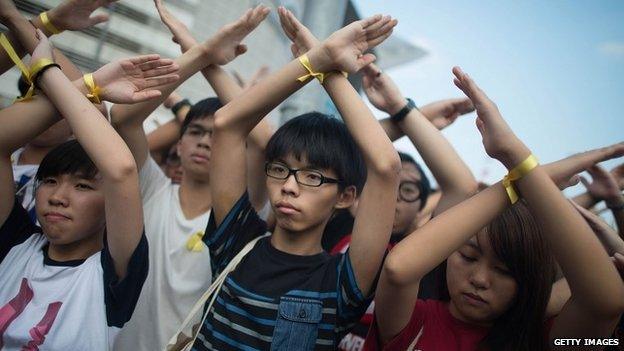
Protest leader Joshua Wong (centre) has become a key figure in the demonstrations
But it has now been widely adopted by pro-democracy campaigners.
"It symbolises that we are against the current political balance in Hong Kong," Mike Cheung, a student and protester, told the BBC.
"But it also shows that we are not holding any weapons or utilising violence."

Umbrellas
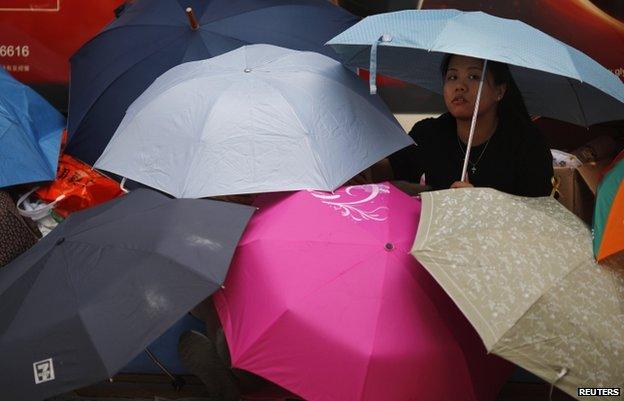
Umbrellas have become one of the unofficial icons of the movement
They were originally intended to protect against sunshine and rain - but protesters were forced to use umbrellas to defend themselves against police tear gas and pepper spray when clashes broke out on Sunday.
Since then, umbrellas have become one of the unofficial icons of the movement, so much so that it has become known as the "umbrella revolution".
The umbrellas have also become a protest art phenomenon online, external, with Hong Kong artist Kacey Wong leading a call for designers to create images to represent the campaign.
"The umbrella has been transformed from a normal everyday object to a symbol of defiance, a symbol of resistance," Mr Wong told the BBC.

Songs
Under a Vast Sky by the Cantonese rock band Beyond has become a popular anthem for protesters
Demonstrators have been indulging in mass sing-along sessions in the streets, with a Cantonese hit from the 1990s becoming a popular anthem.
Under a Vast Sky by Canto-rock band Beyond, external, which has lyrics about longing for freedom, has become a crowd favourite.
Many protesters are too young to remember its release in 1993.
But Mike Cheung said the song remained popular because it had taken on a special significance.
"The band Beyond was about more than just music performances - they represented the people of Hong Kong and motion in society," he said.
"We love the music and we love the message as well."
Other favourites include Do You Hear the People Sing? from the musical Les Miserables and John Lennon's Imagine.
Lyrics from the songs have been painted on banners strung across buildings and bridges.
Meanwhile China's state news agency Xinhua published a report on Friday , externalabout a video showing what it called a "worried uncle" tearfully singing a song , externalentitled "waiting for you to come back". The agency said the video had gone viral.

Memes
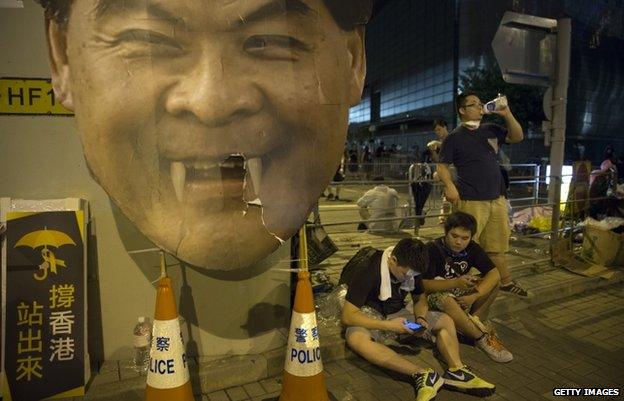
A vampire is just one of the negative ways CY Leung has been portrayed
Images of Hong Kong's vilified leader CY Leung as a devil and a vampire have appeared both on the internet and in the streets.
One cartoon showed the leader with a baby's dummy and the slogan "Good baby", AFP news agency reports, in reference to Mr Leung being considered Beijing's stooge.
A stuffed toy wolf stocked by Swedish furniture giant Ikea has also become an unlikely symbol of the protest.
The character is called Lufsig in Hong Kong - but its Chinese name sounds similar to a Cantonese profanity.
Critics have long nicknamed Mr Leung "the wolf".

Numbers
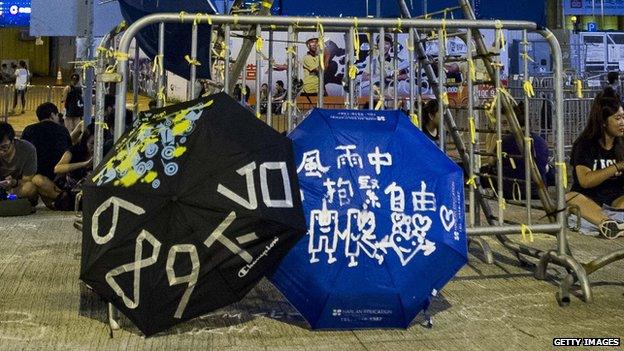
The number 689 appears widely at the protests
In their calls for him to step down, Hong Kong's pro-democracy activists mockingly call Mr Leung "689".
It refers to his backing by Beijing and the number of votes he received from China's electoral committee in 2012.
Other figures used by demonstrators include 926, which refers to 26 September when the street protests kicked off, and 8964, the date of the Tiananmen crackdown.
Commentators say numbers are useful political shorthand in Hong Kong and mainland China, where critics complain of limits placed on free speech.